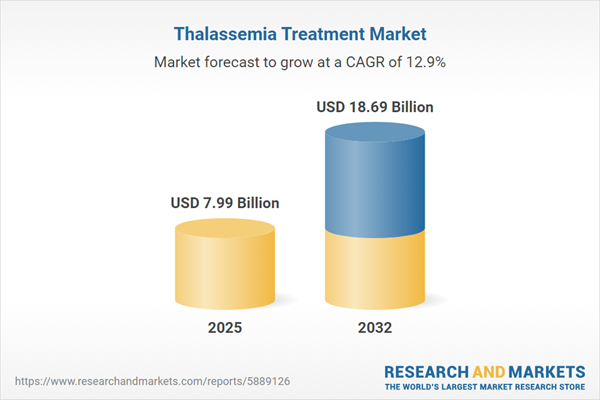Speak directly to the analyst to clarify any post sales queries you may have.
Navigating the thalassemia treatment market requires senior executives to blend strategic vision with timely market intelligence. Rapid innovation and evolving standards of care are redefining competitive benchmarks, making it essential to leverage actionable insights for effective leadership outcomes.
Market Snapshot: Thalassemia Treatment Market Overview
The thalassemia treatment market is on a robust growth trajectory, supported by continual advancements in therapeutic approaches and rising research activity. Strategic competition is intensifying as curative and disease-modifying therapies enter the landscape, driving organizations to innovate rapidly. Regulatory bodies are focusing on compliant, patient-centric care models, necessitating that businesses adapt to both evolving standards and increasing digital integration in care delivery. Operational efficiency and workforce agility are becoming critical as investments shift toward disruptive medical interventions. Senior leaders are expected to make informed, agile decisions to secure and expand market relevance in a dynamic healthcare environment.
Scope & Segmentation: Comprehensive Market Structure
- Therapeutic Approach: Blood transfusions deliver immediate management; gene therapy, iron chelation, and stem cell-based treatments enable tailored, longer-term disease modification.
- Drug Type: Oral and dispersible deferasirox, various deferiprone forms, and injectable or infusion-based deferoxamine address patient and clinical diversity in thalassemia therapy.
- End User: Home settings, general and specialty hospitals, and designated hematology clinics ensure broad patient access and greater healthcare system integration.
- Distribution Channel: Tenders, hospital and retail pharmacies, and digital sales channels support continuity and efficiently address shifting demand across regions.
- Payer Type: Access is influenced by public funding, insurance, and self-pay, resulting in regional reimbursement variations and affecting uptake of new technologies.
- Regions: Americas, Europe, Middle East and Africa, and Asia-Pacific segments reflect varying disease prevalence, healthcare infrastructure, and therapy adoption pathways.
- Key Companies: Novartis AG, Bluebird Bio, Bristol-Myers Squibb Company, Pfizer Inc., Grifols, Kedrion, LFB, Recordati Rare Diseases, Apotex, and Octapharma build competitive advantage with product portfolios, focused launches, and strategic partnerships.
Key Takeaways for Strategic Decision-Makers
- Advances in gene editing and vector-driven therapies are redefining standard protocols, increasing demand for innovation in R&D and sustained investment in product pipelines.
- Development of new oral and subcutaneous options enhances adherence and opens access in various clinical environments, streamlining the patient pathway.
- Shifting regulatory and reimbursement frameworks require close monitoring and adaptable strategies to ensure ongoing compliance and market presence.
- Localization of strategy in emerging and high-prevalence markets allows better alignment with regional care systems and helps reach under-addressed populations.
- Strengthening supply chains through diversified sourcing and collaborative partnerships minimizes disruptions and maintains business continuity.
Tariff Impact: Managing U.S. Trade Policy Effects
Ongoing U.S. tariffs on essential medical imports are raising cost pressures across the thalassemia treatment segment. To reduce exposure to such policy shifts, companies are strategically diversifying supplier bases and developing new local partnerships. This approach stabilizes the supply chain and maintains a consistent market position.
Methodology & Data Sources
This assessment synthesizes findings from interviews with clinicians, payers, and advocacy groups, complemented by recent clinical trial data and regulatory intelligence. An executive advisory panel reviews each recommendation to ensure alignment with leadership priorities in the thalassemia treatment sector.
Why This Report Matters
- Provides leadership teams with critical market, therapeutic, and regulatory insight for actionable strategic and operational planning.
- Enables organizations to adapt quickly to changing payer and reimbursement dynamics, improving planning confidence and supporting timely growth initiatives.
- Clarifies the impact of competitive and technological shifts for effective resource alignment and opportunity assessment.
Conclusion
Up-to-date, evidence-based intelligence empowers senior leaders to target growth, manage risks, and maintain operational resilience as the thalassemia treatment market continues to evolve.
Additional Product Information:
- Purchase of this report includes 1 year online access with quarterly updates.
- This report can be updated on request. Please contact our Customer Experience team using the Ask a Question widget on our website.
Table of Contents
3. Executive Summary
4. Market Overview
7. Cumulative Impact of Artificial Intelligence 2025
Companies Mentioned
The companies profiled in this Thalassemia Treatment market report include:- Novartis AG
- Bluebird Bio, Inc.
- Bristol-Myers Squibb Company
- Pfizer Inc.
- Grifols, S.A.
- Kedrion S.p.A.
- LFB S.A.
- Recordati Rare Diseases S.r.l.
- Apotex Inc.
- Octapharma AG
Table Information
| Report Attribute | Details |
|---|---|
| No. of Pages | 194 |
| Published | October 2025 |
| Forecast Period | 2025 - 2032 |
| Estimated Market Value ( USD | $ 7.99 Billion |
| Forecasted Market Value ( USD | $ 18.69 Billion |
| Compound Annual Growth Rate | 12.9% |
| Regions Covered | Global |
| No. of Companies Mentioned | 11 |









